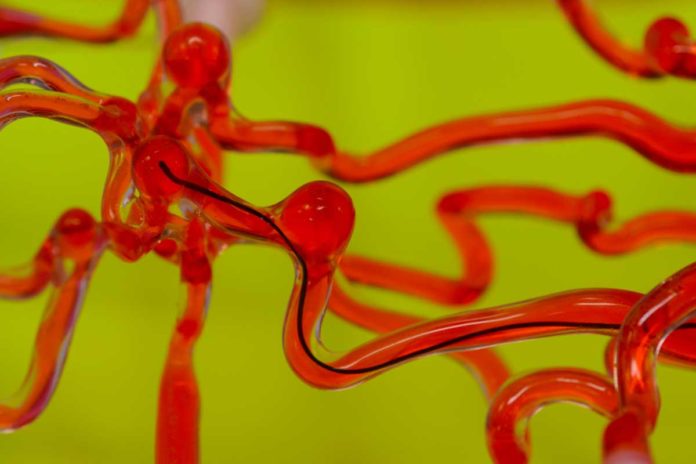Small-scale elastic continuum robots capable of active steering and navigation in a remotely controllable manner hold great promise in diverse areas, particularly in medical applications. Existing continuum robots, however, are often limited to a millimeter or centimeter scales due to miniaturization challenges inherent in conventional actuation mechanisms, such as pulling mechanical wires, inflating pneumatic or hydraulic chambers, or embedding rigid magnets for manipulation.
MIT engineers now have developed a robotic thread that can actively slide through narrow, winding pathways, such as the labyrinthine vasculature of the brain.
Surgeons often perform an endovascular procedure to remove blood clots from the brain. The process is invasive, where the surgeon inserts a thin wire through a patient’s main artery, usually in the leg or groin. Guided by a fluoroscope that at the same time pictures the veins utilizing X-rays, the specialist then manually pivots the wire up into the damaged brain vessel. A catheter would then be threaded up along the fence to convey medications or clot retrieval devices to the affected area.
However, the procedure is physically taxing, requiring surgeons, who must be specially trained in the task, to endure repeated radiation exposure from fluoroscopy.
Scientists realized that the developments in their lab could help improve such endovascular procedures.
Over the past few years, the team has built up expertise in both hydrogels — biocompatible materials made mostly of water — and 3-D-printed magnetically-actuated materials that can be designed to crawl, jump, and even catch a ball, by merely following the direction of a magnet.
Scientists, in this new work, combined their work in hydrogels and magnetic actuation, to produce a magnetically steerable, hydrogel-coated robotic thread, or guidewire, which they were able to make thin enough to magnetically guide through a life-size silicone replica of the brain’s blood vessels.
The core of the robotic thread is made from a nickel-titanium alloy, or “nitinol,” a material that is both bendy and springy. Unlike a clothes hanger, which would retain its shape when bent, a nitinol wire would return to its original form, giving it more flexibility in winding through tight, tortuous vessels. The team coated the wire’s core in a rubbery paste, or ink, which they embedded throughout with magnetic particles.
Finally, they used a chemical process they developed previously, to coat and bond the magnetic covering with hydrogel — a material that does not affect the responsiveness of the underlying magnetic particles and yet provides the wire with a smooth, friction-free, biocompatible surface.
They demonstrated the robotic thread’s precision and activation by using a large magnet, much like the strings of a marionette, to steer the thread through an obstacle course of small rings, reminiscent of a thread working its way through the eye of a needle.
The researchers also tested the thread in a life-size silicone replica of the brain’s major blood vessels, including clots and aneurysms, modeled after the CT scans of an actual patient’s brain. The team filled the silicone vessels with a liquid simulating the viscosity of blood, then manually manipulated a large magnet around the model to steer the robot through the vessels’ winding, narrow paths.
Lead author Yoonho Kim, a graduate student in MIT’s Department of Mechanical Engineering said, “The robotic thread can be functionalized, meaning that features can be added — for example, to deliver clot-reducing drugs or break up blockages with laser light. To demonstrate the latter, the team replaced the thread’s nitinol core with an optical fiber and found that they could magnetically steer the robot and activate the laser once the robot reached a target region.”
Sooner rather than later, he imagines endovascular medical procedures that include existing magnetic innovations, for example, sets of large magnets, the directions of which specialists can control from merely outside the operating room, away from the fluoroscope imaging the patient’s brain, or even in a different area.
Kim said, “Existing platforms could apply a magnetic field and do the fluoroscopy procedure at the same time to the patient, and the doctor could be in the other room, or even in a different city, controlling the magnetic field with a joystick. We hope to leverage existing technologies to test our robotic thread in vivo in the next step.”
The study is published in the journal Science Robotics.
